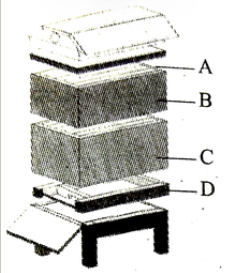The colony of termites is called a. Termitorium b. Cage c. Hive d. Comb
The colony of termites is called Termitarium.
Related Solutions
What is the use of: (a) Uncapping knife (b) Bee brush (c) Queen introducing cage (d) Feeders (e) Honey Extractor (F) Hive Entrance Guard
View Solution………….. Is the maintenance of honey bee colonies, commonly in hives, by humans.
View Solution…………………… is the rearing of honey bee colonies, commonly in hives.
View SolutionThe maintenance of honey bee colonies in manmade hive is known as ........
View SolutionWhich one of the following insects cannot be called a 'social insect' ?
A. Bees
B. Crickets
C. Termites
D. Ants
View Solutionhive : bee : : eyrie : ? (a) Parrot (b) Pigeon (c) Eagle (d) Sparrow
View SolutionVisitors to the zoo (A)/are amused by the monkeys (B)/play in the cages (C)/No error (D)/
View SolutionWhich is economically useful insect?
(a) Mantis religiosa
(b) Termites
(c) Taccardia lacca
(d) Carausius
View SolutionWhich is economically useful insect?
(a) Mantis religiosa
(b) Termites
(c) Taccardia lacca
(d) Carausius
View SolutionName the kind of interaction between the following - (a) Birds and cattle (b) Termites and flagellates (c) Alga and fungus (d) Plasmodium and humans
View SolutionWhat is a rib cage called?
View SolutionWhat is a bone cage called?
View SolutionIdentify the parts marked as A, B, C and D for the below diagram "Langstroth bee hive".

View SolutionIdentify the parts marked as A, B, C and D for the below diagram "Structure of hive showing various cells".
View SolutionName the following.
i. The largest bee in the colony.
View SolutionDestruction of hives of bees due to pesticides is called ________
View Solutionजो तना भूमिगत ऊधर्वा वृध्दि करता है, कहलाता है :
View SolutionThe maintenance of hives of honey bees for the production of honey is called _____________
View SolutionWhy are Ctenophores called comb jellies?
View SolutionWhich of the following option is not important for successful bee-keeping? (a) selection of suitable location for keeping the beehives (b) knowledge of the nature and habits of bees (c) catching of drones only and their hiving for starting Epiculture (d) catching and hiving of swarms
View Solution